High-quality real estate images drive buyer engagement and increase inquiries. This article, with case studies, explores the impact of real estate photo editing, including HDR, virtual staging, and color correction, on buyer perception and real estate transactions.
Contents
In real estate, first impressions sell homes – and those impressions start online. With 97% of homebuyers using the internet in their home search, property listings must capture attention instantly. If your photos don’t stand out, buyers move on. Because in real estate, everything depends on the visuals.
Importance of high-quality visuals in real estate marketing
High-quality visuals drive buyer engagement, enhance perceived property value and guide buyer choice. Professional photos, virtual tours, and 3D renderings create strong first impressions, making listings stand out and attract serious buyers. In the digital space, visuals play a crucial role, with 41% of buyers finding photos to be the most useful feature on a website.
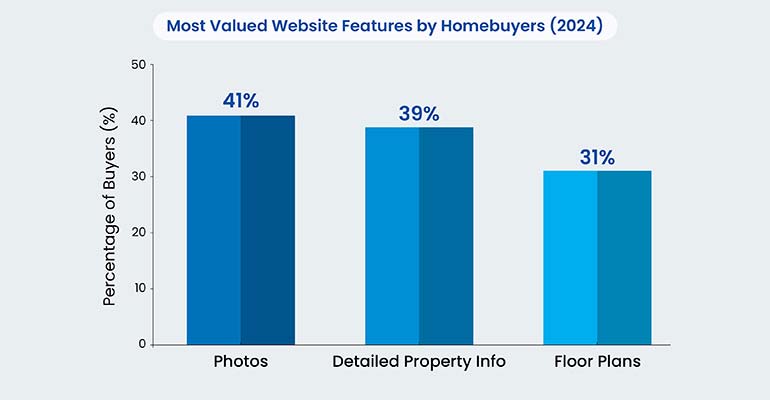
This highlights the need for well-crafted imagery and comprehensive listing details to capture interest and drive conversions. Compelling visuals not only increase inquiries but also help buyers envision the space, leading to faster sales.
Among buyers’ agents, having photos (77 percent) available for their listings was much more or more important to their clients.
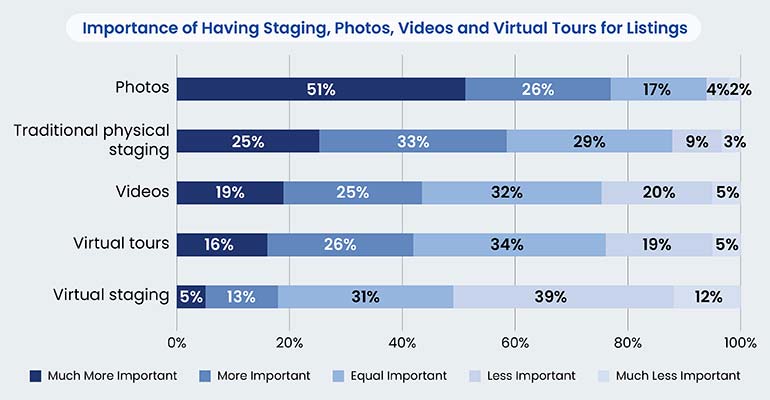 Source: nar.realtor
Source: nar.realtor
Additionally, advanced marketing tools like virtual staging, virtual tours and videos further enhance property appeal, making high-quality visuals a critical asset for real estate success.
This article examines how professional real estate photo editing enhances property inquiries, backed by case studies and actionable insights. By utilizing techniques like HDR processing, virtual staging, and color correction, real estate professionals can boost buyer engagement, enhance property perception, and speed up successful transactions.
How photo editing enhances property listings
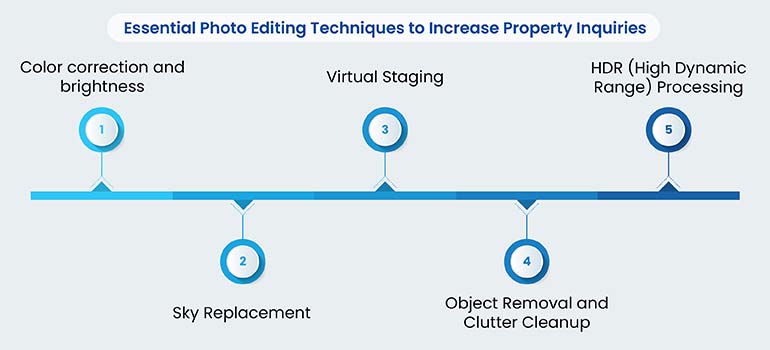
1. Color correction and brightness
Color correction and brightness adjustments are essential photo-editing techniques used to enhance real estate images. Color correction ensures accurate, natural-looking tones by adjusting white balance, contrast and saturation. Brightness adjustments optimize exposure to make spaces appear well lit and inviting. These refinements eliminate distortions caused by poor lighting, incorrect camera settings or unfavorable shooting conditions.
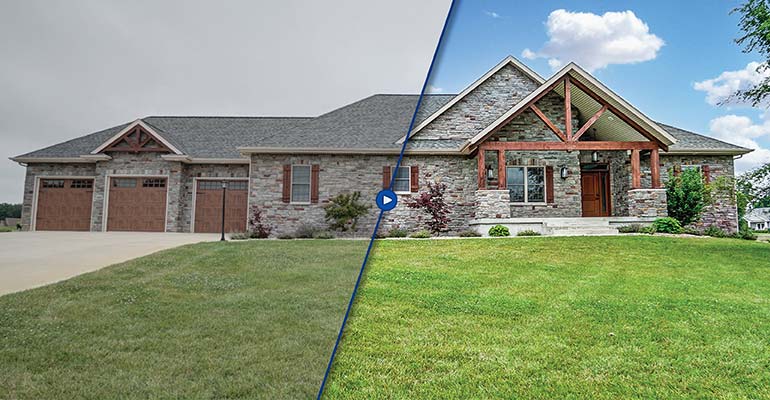
How color correction helps in sales and conversion
- Creates a Visually Appealing Listing: Well-balanced images attract more attention on real estate platforms, increasing click-through rates and engagement.
- Reduces Buyer Hesitation: Dark, shadowy images can make a property seem smaller or less inviting, while color-corrected, brightened photos build buyer confidence.
- Increases Inquiries and Showings: High-quality images improve first impressions, leading to higher lead generation and faster conversions.
- Maintains Listing Consistency: Color-corrected images ensure that photos across different platforms maintain a professional, uniform look, reinforcing brand credibility for agents and sellers.
2. Sky replacement
Sky replacement is a photo editing technique that enhances real estate images by replacing dull, overcast or washed-out skies with a bright, clear or visually appealing sky. This method ensures that property exteriors look vibrant and inviting, regardless of the actual weather during the shoot.
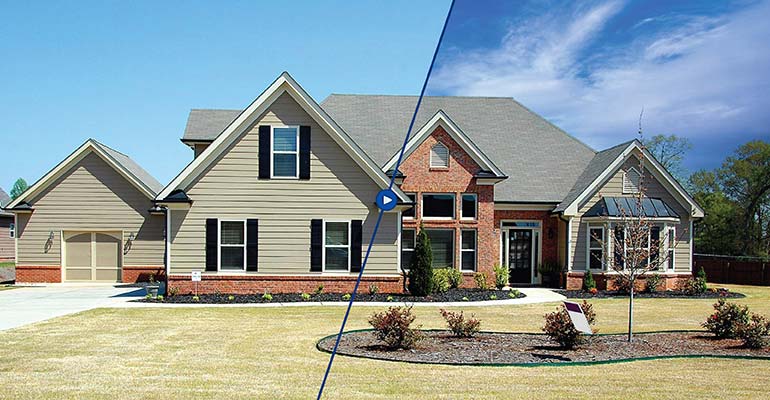
How sky replacement helps in sales and conversion
- Enhances First Impressions: A bright, clear sky makes the property look more attractive and well-maintained, increasing buyer interest.
- Boosts Engagement: Listings with vibrant, professionally enhanced images receive more views, as buyers are drawn to well-lit, appealing visuals.
- Increases Buyer Confidence: A polished, high-quality exterior photo creates a sense of reliability and professionalism, making buyers more likely to inquire.
- Shortens Time on Market: Properties with visually appealing sky-enhanced images sell faster as they stand out in competitive listings.
- Maximizes Listing Potential: Poor weather can make even the best properties look dull. Sky replacement ensures consistent, high-quality images, making every listing market ready.
People also read: How to Replace Sky in Photoshop like a Pro
3. Virtual staging
Virtual staging is a photo editing technique that digitally furnishes an empty or outdated property to make it more visually appealing. Using advanced 3D rendering and image manipulation, virtual staging allows real estate professionals to showcase a fully furnished home without physically staging it.
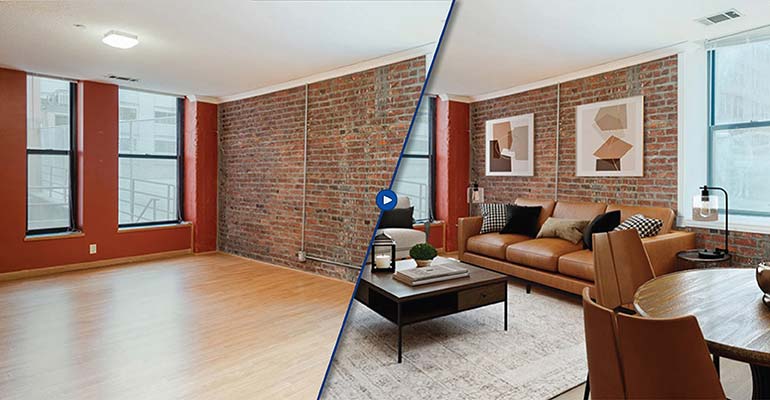
Whether it’s a vacant apartment, an under-construction home, or a commercial space, virtual staging services adds furniture, décor, and lighting elements to create a compelling and market-ready listing.
Learn how virtual staging increases real estate inquiries
- Buyers often struggle to visualize the potential of an empty space. Virtual staging overcomes this challenge, leading to higher engagement and increased property inquiries.
- Listings with virtually staged images receive more views than those with empty or cluttered spaces.
- A well-staged image creates an emotional connection, helping buyers see the home as move-in ready, which can lead to higher offers.
- Traditional staging costs $2,000–$5,000 per month, whereas virtual staging can be done for $50–$150 per image, making it a high-ROI investment.
- Properties with staged images sell 73% faster, as buyers are likelier to request site visits when they see a well-presented space.
4. Object removal and clutter cleanup
Object removal and clutter cleanup are essential real estate photo editing techniques that eliminate distractions from property images, ensuring a clean and professional presentation. A well-composed, clutter-free image allows potential buyers to focus on the property’s key features rather than unnecessary distractions.
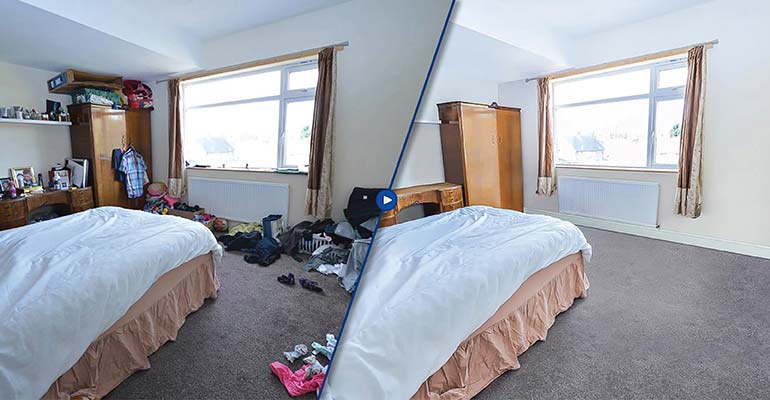
Decluttering digitally creates a visually appealing and market-ready listing. Here’s how object removal and clutter cleanup contribute to increased inquiries and faster sales:
- Listings with professionally edited clutter-free images receive more views as buyers are naturally drawn to clean, organized spaces.
- A well-presented space feels larger, brighter and more valuable, allowing buyers to envision themselves in the home more easily.
- When distractions are removed, buyers focus on the architecture, layout and finishes rather than minor imperfections or clutter.
- Homes with decluttered, professionally edited images sell faster than listings with poorly composed visuals.
- Real estate agencies that consistently use clutter-free, high-quality images in their listings establish a stronger brand presence and attract more qualified buyers.
5. High dynamic range (HDR) processing
HDR (High Dynamic Range) processing is a real estate photo editing technique. It blends multiple exposures to create a single, well-balanced image. By capturing a series of shots at different brightness levels, underexposed, correctly exposed, and overexposed; HDR processing ensures that both bright and dark areas retain their details.
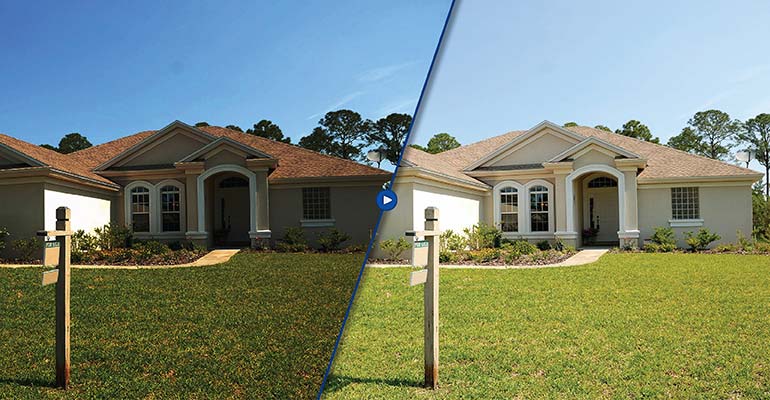
Comparison: Standard vs. HDR-Edited Images
| Feature | Standard Image | HDR-Edited Image |
|---|---|---|
| Lighting Balance | Uneven; bright spots overexposed; shadows too dark | Even lighting across the entire image |
| Details & Textures | Some details lost in dark and bright areas | Enhanced clarity in both shadows and highlights |
| Window Views | Windows appear too bright (blown out) | Outdoor scenery visible through windows |
| Color Accuracy | Washed out or overly warm tones | Natural, vibrant colors preserved |
| Overall Impact | Flat, lacks depth | Dynamic, eye-catching, and professional-looking |
How HDR drives real estate conversions and sales
- Listings with HDR-enhanced images receive 118% more online views than standard photos. Buyers browsing online platforms are drawn to well-lit, high-contrast images that make properties appear more inviting.
- HDR ensures window views remain visible while interiors maintain clarity. This helps buyers better understand the property’s surroundings, layout and lighting conditions, leading to higher engagement and inquiries.
- Properties that maintain a uniform HDR editing style across all images project a polished, high-end feel, increasing buyer confidence in the listing.
- Studies show that professionally edited real estate images, including HDR, can contribute to homes selling for $3,000 to $11,000 more than those with lower-quality visuals.
- Homes with high-quality, well-lit images sell 32% faster because buyers can evaluate listings more efficiently and develop emotional connections with the property.
Boost inquiries with high-quality real estate photos
Get in touch now »6. Twilight effects
The Twilight Effect is a photo editing technique that transforms daytime property images into stunning twilight or dusk-like visuals. Adjust lighting, color balance, and sky replacement. This technique enhances exterior real estate images, making properties appear more luxurious, well lit, and visually captivating.
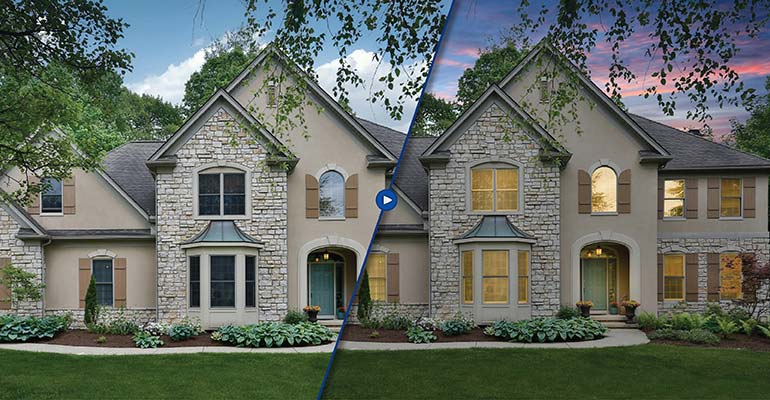
How the Twilight effect boosts real estate conversions
- Twilight images stand out in a sea of standard daylight property listings. The soft, warm hues of a digitally enhanced sunset make the home look more inviting, increasing engagement and click-through rates on listing platforms.
- A well-edited twilight image can make a home appear more luxurious, especially when exterior lighting and window glows are enhanced.
- This photo editing technique works well for luxury homes, waterfront properties, and vacation rentals, as they create a dreamy, aspirational aesthetic that attracts high-intent buyers.
HDR Editing of Real Estate Images to be Distributed on Internet and MLS
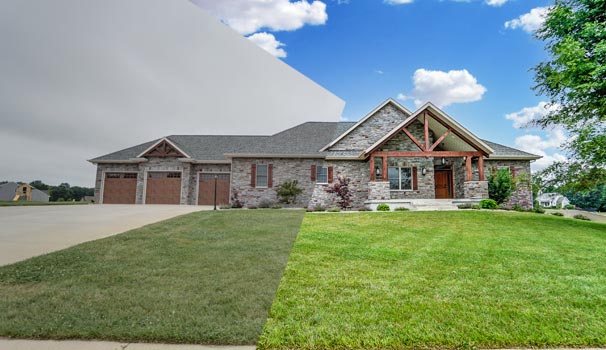
HabileData helped a real estate image editing company process 3,000 images daily, with a 12-hour turnaround for MLS, Realtor.com, and social platforms. The client faced challenges in image selection, maintaining photographer style, and workflow efficiency.
To solve this, HabileData deployed expert HDR and virtual staging teams using Adobe Photoshop and Lightroom for precision editing. A technology-backed workflow and time zone advantage enabled seamless round-the-clock processing.
The result? Faster delivery, reduced costs, and high-quality MLS-ready images, enhancing buyer engagement and brand credibility.
HabileData collected, standardized, and verified property data from over 1,350 sources for a U.S.-based real estate consultant. The process improved the accuracy of their MLS database, enhanced user experience, increased market presence and boosted brand credibility.
Read full case study »Best practices for real estate photo editing
High-quality property images can significantly impact buyer engagement, leading to increased inquiries and faster transactions. Implementing best practices in real estate photo editing ensures that images not only capture attention, but also maintain accuracy and credibility.
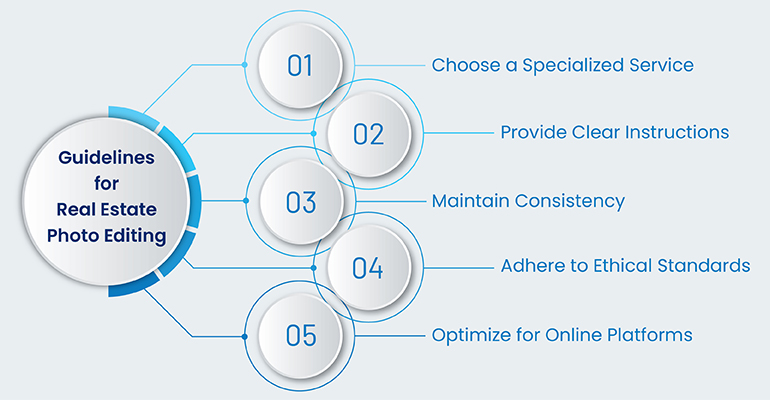
1. Choosing a professional photo editing service
Real estate photo editing is not just about enhancement. It’s about presenting properties accurately while maximizing their appeal. Professional editors understand lighting balance, perspective corrections, and natural color grading, ensuring properties look inviting without artificial exaggeration. Over-processing can mislead buyers and damage trust, so striking the right balance is key.
2. Providing clear instructions
Editors are skilled, but clear direction enhances results. Real estate professionals should specify requirements like brightness levels, sky replacements, or clutter removal to create images that reflect the home’s real potential. Reference images and feedback loops prevent excessive revisions and maintain listing accuracy.
3. Maintaining consistency
A disjointed presentation across multiple properties weakens brand credibility. Ensuring a uniform editing style in lighting, color tones, and composition helps create a professional portfolio that builds buyer confidence. This is especially important for agencies managing large inventories.
4. Ethical considerations
Buyers expect realism, not deception. Adjustments should correct exposure, enhance clarity, and remove distractions without altering a property’s fundamental characteristics. Misleading edits, such as altering room dimensions or removing flaws, can result in legal issues and lost trust.
5. Optimizing images for online platforms
Each real estate platform has different image requirements. High-resolution yet optimized images (JPEG, 2048 x 1536 pixels) ensure listings look sharp across websites and social media without slowing page load times. Well-optimized visuals increase engagement and reduce bounce rates on listing pages.
Conclusion
In real estate, high-quality visuals don’t just attract attention and drive inquiries. Buyers form opinions in seconds, and professionally edited images can mean the difference between a property that gets overlooked and one that generates immediate interest.
Techniques like HDR processing, sky replacement, virtual staging, and object removal make listings more engaging, helping buyers visualize the space before ever stepping inside. But achieving consistency and efficiency at scale is a challenge. Outsourcing real estate photo editing ensures faster turnaround, expert precision, and cost-effective solutions, allowing agents to focus on client interactions rather than post-production.
The result is a noticeable increase in inquiries, improved engagement, and reduced time on the market. Professionally edited images enhance listing appeal, making it easier for buyers to connect with a property and take the next step in the buying process.
Outsource your real estate photo editing requirements!
Contact us now »
HabileData is a global provider of data management and business process outsourcing solutions, empowering enterprises with over 25 years of industry expertise. Alongside our core offerings - data processing, digitization, and document management - we’re at the forefront of AI enablement services. We support machine learning initiatives through high-quality data annotation, image labeling, and data aggregation, ensuring AI models are trained with precision and scale. From real estate and ITES to retail and Ecommerce, our content reflects real-world knowledge gained from delivering scalable, human-in-the-loop data services to clients worldwide.






